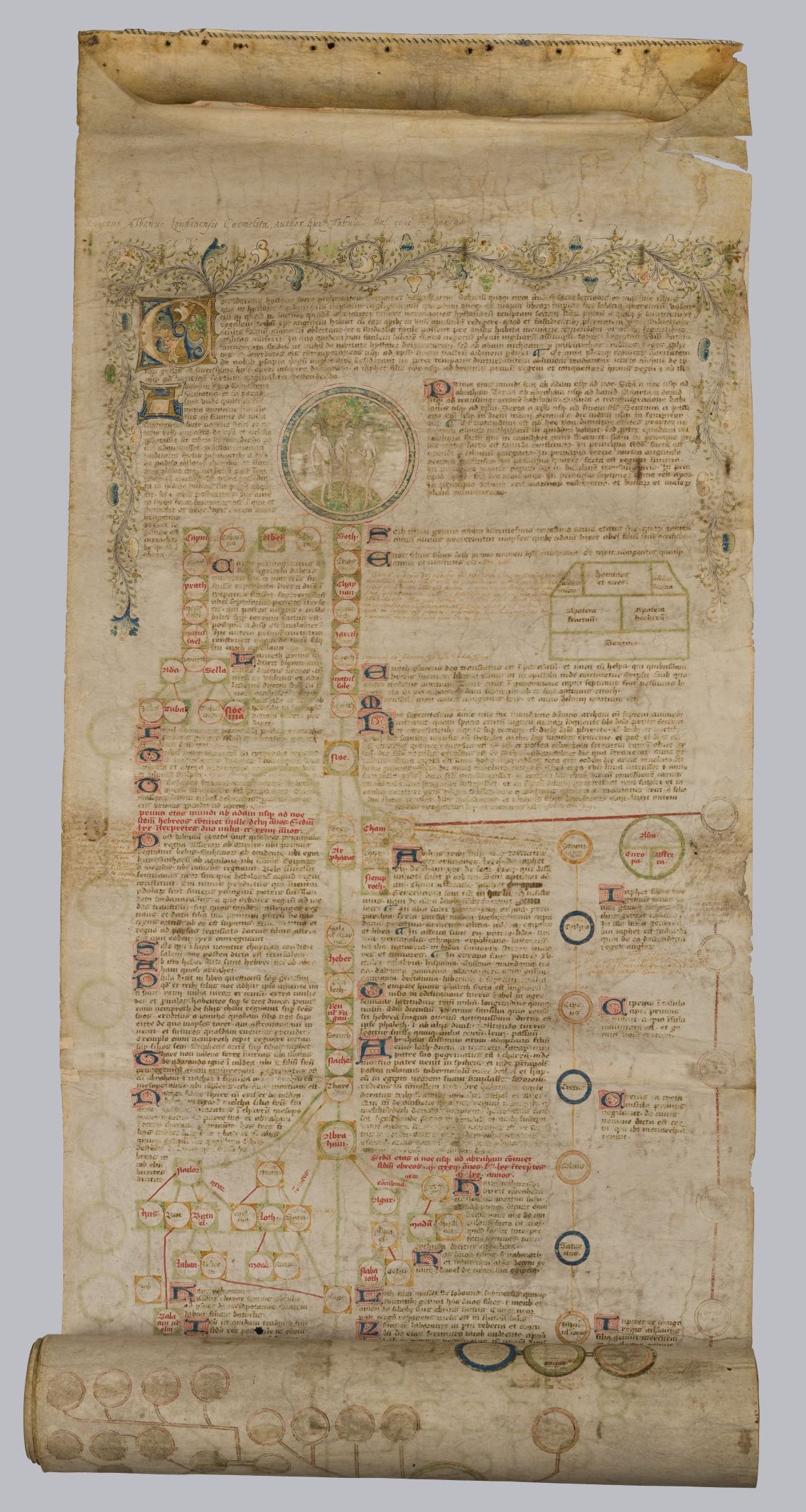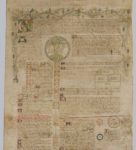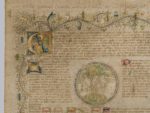
Genealogy of the English Kings to Edward IV, c. 1461 with later additions [MS13A]
England
Manuscript on roll of 9 membranes, previously fastened to a roller (59 x 36 cm)
On both sides of the roll are genealogies (family trees). The tree on the face (front of the roll) shows the descent of the Kings and Queens of England to Adam and Eve, and was drawn in the mid-15th century. On the dorse (back of the roll) are a collection of genealogies that were added later. Like other rolls of this type, the chronicle promoted the validity of the current monarch’s claim to the throne.
The face begins with Creation—shown by a roundel of the Fall in which Eve accepts the forbidden fruit from a serpent—and ends with the proclamation of the reign of Edward IV. The absence of his coronation suggests the roll was made before then, probably between March and June of 1461. This type of genealogy is referred to as a ‘Considerans’ chronicle, named after the prologue, which begins: Considerans histories acre prolixitatem necnon et difficultatem. Other rolls with this content survive, and have been categorised by Albinia de la Mare as the ‘long Latin’ type. These include London, British Library, Harley Roll C9 and Lansdowne MS 456; Copenhagen, Det Kongelige Bibliothek, NKS 1858; Cambridge, Trinity College, R.4.3; Aberystwyth, National Library of Wales, Brogyntyn II.52; and Oxford, St John’s College MS 23. The rolls were probably written in London or Westminster, before they were passed on to another workshop to be decorated.
In each, the text is initially divided into three columns alongside the lines of descent, represented by the names of figures in coloured circles. They show biblical history from Adam and Eve to the Apostles, and the descent of Old Testament figures, the Hebrew Kings, and the British Kings. A more detailed description of the genealogical content is available in the British Library’s catalogue entry for Lansdowne MS 456. Not only is its text very similar, but it was also decorated in the same workshop as MS13A, as also was British Library, Royal MS 14 B VIII. The genealogy is interspersed with images, including a schematic Ark of Noah, a T-O world map (showing the world divided into Asia, Africa and Europe), and diagrams of the tabernacle of the twelve Tribes of Israel, the City of Jerusalem, and the seven kingdoms of the Anglo-Saxon Heptarchy.
On the dorse are more family trees that have been added after the 15th century, including the descent of Elizabeth I, the genealogy and relationship of Philip of Spain and Mary Tudor, and a heraldic design in red and purple showing the descent of Henry VI and his claims to the throne of France as well as of England. The family tree that starts at the top of the dorse is in the same hand as a line of descent that has been added on roll’s face, to the right of the earlier genealogy. Both sides have been annotated by multiple later hands, showing an interest in the roll, and its utility for the study of history, that lasted long after the Middle Ages.
Literature: Neil R. Ker and Alan J. Piper, Medieval Manuscripts in British Libraries, Volume IV: Paisley–York (Oxford, 1969), pp. 610–11; Paul Yeats-Edwards, Winchester College (Warden and Fellows’ Library) Medieval Manuscript Collection: Brief History and Catalogue (London, 1978), p. 13; Kathleen L. Scott, Later Gothic Manuscripts 1390–1490, A Survey of Manuscripts Illuminated in the British Isles, 6, Volume 2 (London, 1996), pp. 268, 316; Maree Shirota, ‘Neither Roll nor Codex: Accordion Geneologies of the Kings of England from the Fifteenth Century’, in Stefan G. Holz, Jörg Peltzer, and Maree Shirota (eds), The Roll in England and France in the Late Middle Ages (Berlin, 2019), pp. 265, 273, 284.
Provenance: Unknown, at Winchester College by 1616.
Location: Fellows’ Library

